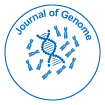Cytogenomics in the -Omics Era Full of Conceptual Chasms
Received: 05-Mar-2018 / Accepted Date: 06-Mar-2018 / Published Date: 09-Mar-2018
Keywords: Cytogenetics; Molecular cytogenetics; Evolution; Genome; DNA
Editorial
Cytogenetics and particularly molecular cytogenetics became established in the basic research across Eukaryotes in the last decades. Clinical (molecular) cytogenetics belongs to routine diagnostics tools enabling and further refining a proper prognosis of diverse diseases. In parallel, genomics has been experiencing a real boom during last years and also became a robust and highly dynamic and powerful field of modern biology. The clinical genomics as a logical consequence of this development experienced however its own “evolutionary trajectory” determined by the level of our knowledge of the human genome and available tools.
Recently, we have defined a non-clinical cytogenomics [1], i.e. a basic research version of the next step of evolution in the -omics world. The need of cytogenomics results among others from the nature of several generations of sequencing technologies that were not allowing assembling genomes in their highly repetitive regions. Whereas the seemingly obsolete and massively abandoned cytogenetics proved its irreplaceable and essential role in countless studies. Another reason, why we need this fusion between the traditional cytogenetics and the progressive genomics is a still deepening gap between these two fields. This gap became a chasm preventing the modern solely genomic approaches from identification of some less predictable or even unpredictable phenomena. In this way, it was only the cytogenetics in the already established genomic era that enabled identification of extremely amplified 5S ribosomal DNA (rDNA) in otherwise in details analysed sequenced genome of Northern Pike (Esox lucius ) [2]. The crucial importance of copy number of the rDNA nuclear genomic fraction however remains behind another chasm, namely, in the sphere of several model species. On the other hand, this realm of yeastmouse- human-only but highly sophisticated research provides us with astonishing results how these ancient genes (45S and 5S rDNA) determine so far unsuspected areas of cellular and genomic functionality [3]. It means that the rDNA copy number contributes to maintenance of genome stability, senescence onset regulation; it mediates genomic response to changing outer environment, etc. In mammals [4] but also in yeast [5], the rDNA copy number is tightly regulated and controlled and any imbalance can result in disorders, e.g. cancer [6,7] in other Eukaryotes it can experience an explosive burst without any obvious negative consequences for coming generations [2]. An easy way, how to identify such situations is molecular cytogenetics (reviewed in animals by [8]. On the other hand, any deeper understanding of such extreme rDNA amplifications can be obtained only from the genomic data enabling insights into the sequence structure of rDNAs. This means genomics without cytogenetics would lose an important irreplaceable tool and the cytogenomics approach has its prospects.
The clinical, particularly the cancer cytogenetics experienced its transition towards cytogenomics already some time ago, e.g. [9,10]. This transition was accompanied by further developments in FISH and CGH technologies resulting in array CGH now routinely used in clinical cytogenomics [10]. However, the current clinical cytogenomics and oncological cytogenomics operate in completely different dimensions and on much finer scales than in any other field of the basic cytogenomic research [11].
To conclude, we can say that there is still another huge chasm between the clinical and non-clinical fundamental cytogenomics and we can look forward to closing or filling it.
References
- Symonová R, Howell WM (2018) Vertebrate Genome Evolution in the Light of Fish Cytogenomics and rDNAomics. Genes 9: 96.
- Symonová R, Ocalewicz K, Kirtiklis L, Delmastro GB, Pelikánová Š, et al. (2017) Higher-order organisation of extremely amplified, potentially functional and massively methylated 5S rDNA in European pikes (Esox sp.). BMC genomics 18: 391.
- Kobayashi T (2016) Genome Instability of Repetitive Sequence: Lesson from the Ribosomal RNA Gene Repeat. In DNA Replication, Recombination and Repair; Hanaoka F, Sugasawa, K. Tokyo, Japan.
- Gibbons JG, Branco AT, Godinho SA, Yu S, Lemos B (2015) Concerted copy number variation balances ribosomal DNA dosage in human and mouse genomes. Proc Nat Acad Sci USA 112: 2485-2490.
- Jack CV, Cruz C, Hull RM, Keller MA, Ralser M, et al. (2015) Regulation of ribosomal DNA amplification by the TOR pathway. Proc Natl Acad Sci USA 112: 9674-9679.
- Wang M, Lemos B (2017) Ribosomal DNA copy number amplification and loss in human cancers is linked to tumor genetic context, nucleolus activity and proliferation. PLOS Genet 13: e1006994.
- Xu B, Li H, Perry JM, Singh VP, Unruh J, et al. (2017) Ribosomal DNA copy number loss and sequence variation in cancer. PLOS Genet 13: e1006771.
- Sochorová J, Garcia S, Gálvez F, Symonová R, KovaÅ™Ãk A (2018) Evolutionary trends in animal ribosomal DNA loci: Introduction to a new online database. Chromosoma 127:141-150.
- Shaffer LG (2004) A cytogeneticist's perspective on genomic microarrays. Hum Reprod Update 10: 221-226.
- Balmain A (2001) Cancer genetics: from Boveri and Mendel tomicroarrays. Nat Rev Cancer 1: 77-82.
- Bernheim A (2010) Cytogenomics of cancers: From chromosome to sequence. Mol Oncol 4: 309-322.
Citation: Symonová R (2018) Cytogenomics in the -Omics Era Full of Conceptual Chasms. J Genome 1: e103
Copyright: © 2018 Symonová R. This is an open-access article distributed under the terms of the Creative Commons Attribution License, which permits unrestricted use, distribution, and reproduction in any medium, provided the original author and source are credited.
Share This Article
Open Access Journals
Article Usage
- Total views: 5161
- [From(publication date): 0-2018 - Mar 28, 2025]
- Breakdown by view type
- HTML page views: 4194
- PDF downloads: 967
